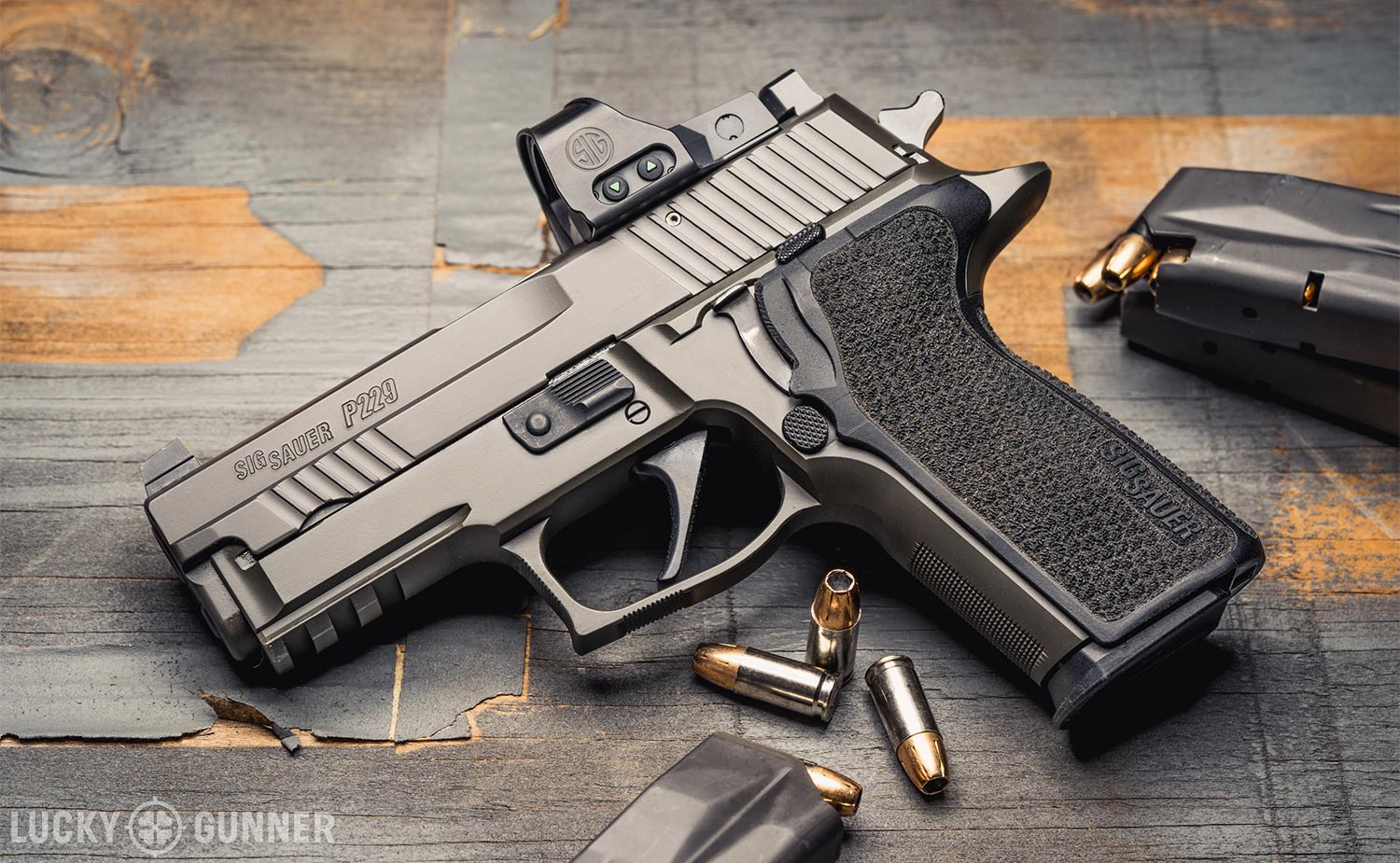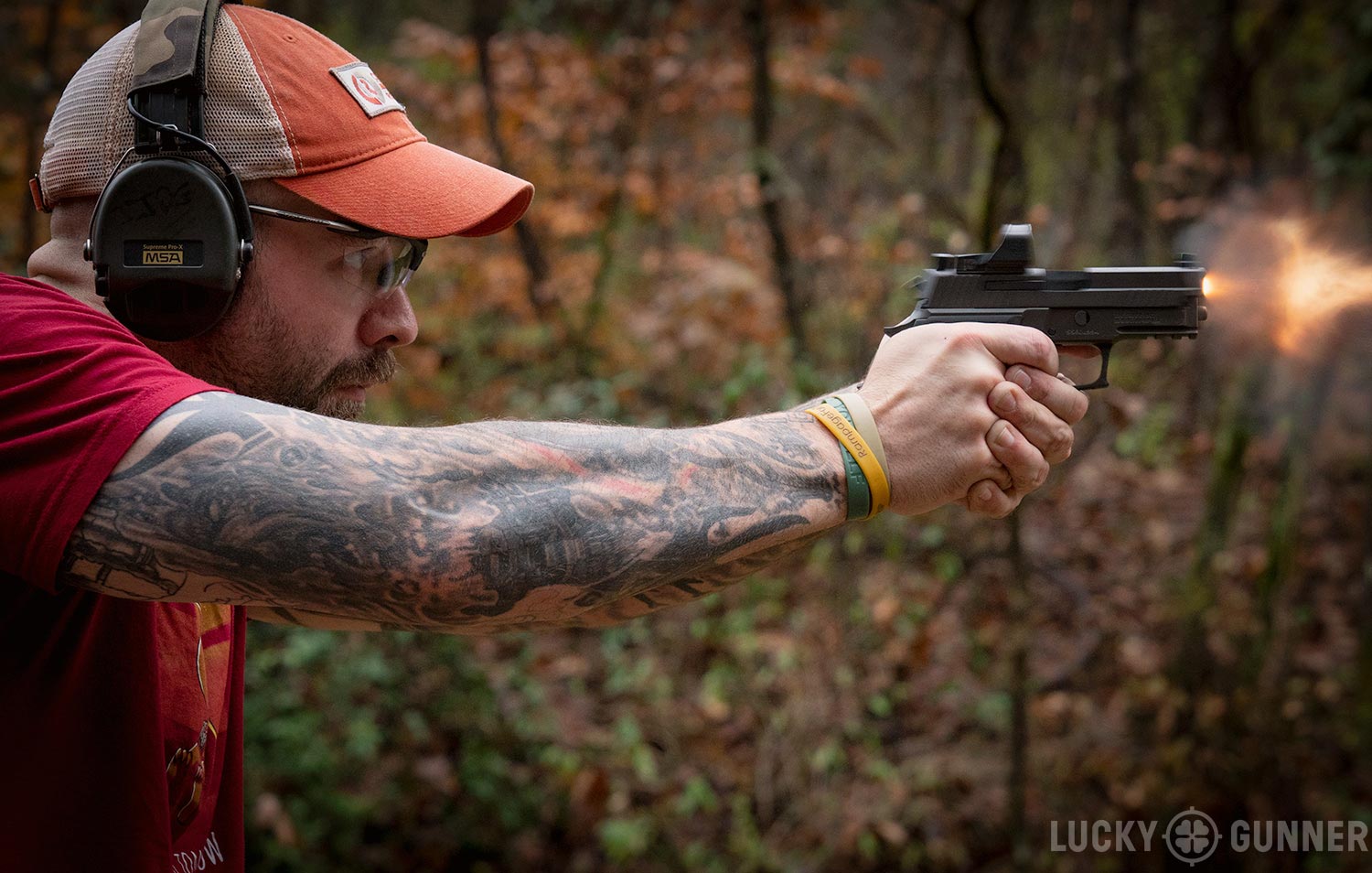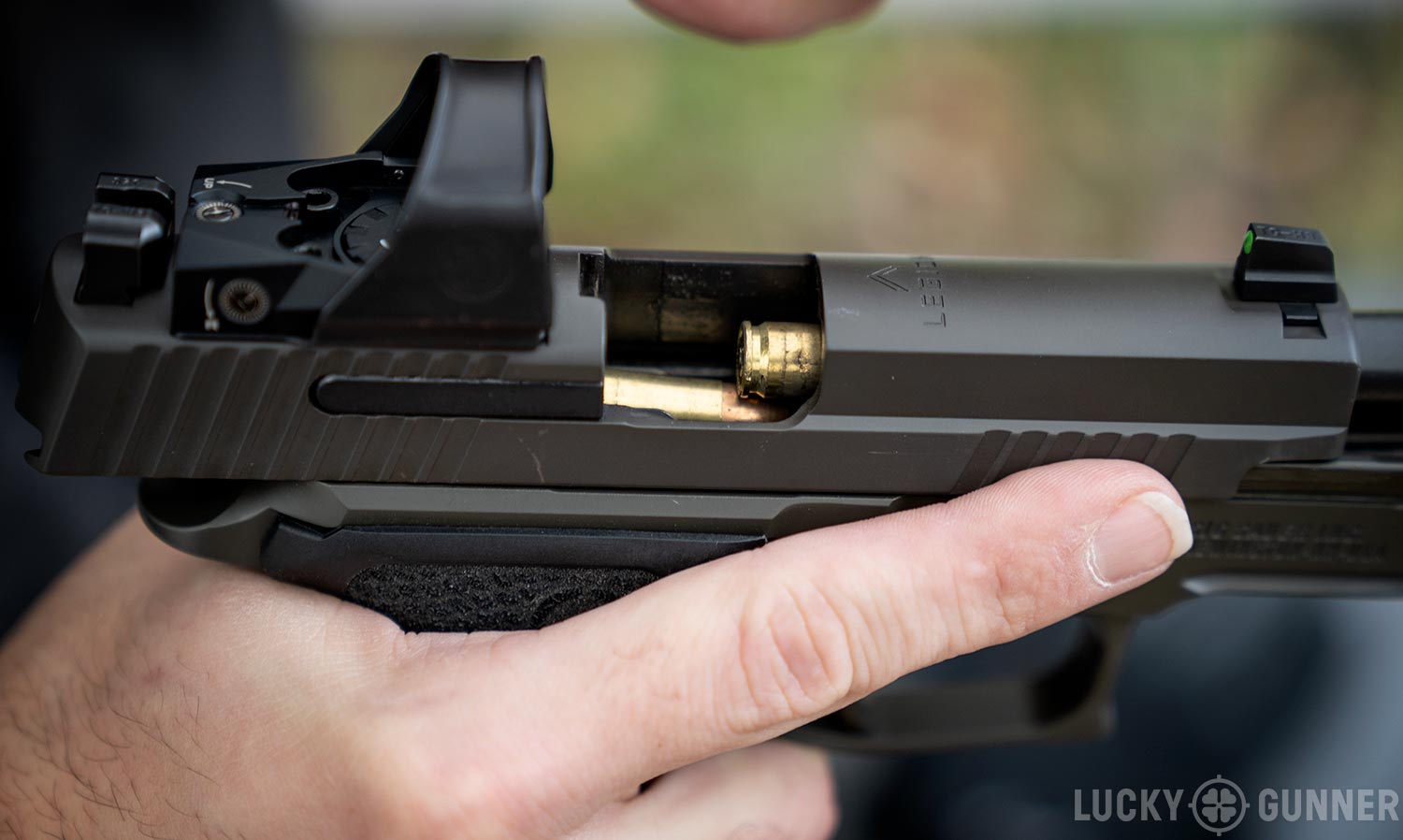Series Shortcuts
It’s a new series! We’re going to subject various firearms to a long-term 10,000-round test to answer the question, “does this gun suck?” First up is a custom Sig Sauer P229 Legion RX equipped with a Sig ROMEO1 red dot sight and some custom parts from Grayguns. Find out more about our test in the video below or just scroll down to read the transcript. We’ll be posting regular updates here on the blog until the test wraps up in a couple of months, so stay tuned!
CHRIS: There are some guns that people seem to just love to hate. Just their very existence tends to rile up various corners of the Internet. We’re going to take some of those guns and actually put them through their paces in a new series we’re going to call “Does This Gun Suck?” With us to help us out is our friend John Johnston. John, why don’t you tell us — what is the first gun we’re going to test?
JOHN: We have a Sig Legion RX P229. “But John, why didn’t you do a 226?” Well, for those of you who have been following me for a little while, I shot 226s for quite some time. I already know about those. The 229, however, is not something have had as much personal experience with. Also, if you’re paying attention, this will seem eerily familiar to something that someone else used to do in the past: Todd Louis Green, who was a major influence on me. One of the last things that he was getting ready to do that he never got a chance to finish was a 229 project. So just all around, it seemed like the right thing to do.
CHRIS: Right, so the late Todd Green, if you’re not familiar with his work, it’s still live on Pistol-Training.com. He did a series of blog posts over the years where he would take a gun and just really run it through its paces — thousands and thousands of rounds through it — just to see what happens with a very high round count on some of these guns. We’re not trying to duplicate what Todd was doing, but this is kind of inspired by that project. So, we’re going to put 10,000 rounds through this gun over the next few months. John is going to do most of that shooting. John, what are we looking for? What are some of the things about this gun that some people might find questionable?
JOHN: Well, there are multiple things that, when you’re in the comments section on the Internet (it’s a dangerous place), people talk about double action/single action being — you’re not able to shoot those to a high degree of performance. Then there are all these questions of, well, “Sig’s current quality control is really horrible.” Okay, let’s find out. And then the optic that we’ve got on the gun is actually going to be one of the Sig optics, the Romeo 1, which I’m very curious to see–
CHRIS: Sig, their new optic line — well, I guess it’s not that new anymore, it’s a few years old now, but they’re still kind of unproven in the optics category.
JOHN: Yeah, there have been a couple of tests done on them, but — another data point is another data point. And then we’ve got some aftermarket stuff. Our gun has the Grayguns Straight Optimized Trigger in it, which is essentially a flat trigger for a double action/single action gun. There’s also a Grayguns grip on it. I thought it would be interesting, to me at least, to see what we could do with a gun that, at this point, is 40 years old — the basic design is 30, 40 years old — and how modernized could it be?
CHRIS: So, this is not a purely scientific test, it’s kind of a mixture. We’re looking at some objective things and we’re also going on what your impressions of the gun are after shooting it that much. We’re looking at a few things — we’re going to track the round count. You’re going to meticulously document how much of each type of ammo you’re going to shoot through it. Your maintenance schedule, which, you’re not really planning to do much of that, right?
JOHN: No, I’m pretty famous for selling guns before I’ll clean them, so the idea of having to clean this on a set schedule is not something that appeals to me. The current plan is that we’re going to lube it every 1000 rounds and clean it if I make the determination that it absolutely needs it.
CHRIS: Right, because most modern semi-autos, especially the polymer striker-fired guns that we’re all familiar with, they should run and run as long as you keep them lubed. That’s typically how it works out. So, if this gun can do the same thing, then it’s not the dinosaur a lot of people think it is.
JOHN: Yeah, exactly. And then we’re also going to look at performance at the beginning of the test on some standards that I shoot pretty regularly anyway. Compare them to my preferred firearm setup and see — can I equal the same performance with a gun that I selected. And also see what kind of improvement there is after 10,000 rounds. And, hopefully, there should be some.
CHRIS: We hope! You’ll also be tracking malfunctions — any kind of stoppage or parts breakage or anything like that. We’ll try to figure out why it happened, but if the gun runs like it should, there shouldn’t be many of those.
JOHN: Right. The industry standard is one malfunction for every 2500 rounds. So, 2500 rounds between failures. So, if this firearm, over the course of 10,000 rounds, experiences four malfunctions or less, that is stellar. Less than that, even better. More than that, ehhhhh — starting to see…
CHRIS: So, we’re going to track malfunctions — that includes malfunctions of the optic, if that starts to choke or if the battery fails before it’s supposed to or something like that. And we’re going to look at the accuracy. We did some group shooting yesterday and we’ll shoot some more groups at the very end to see if that 10,000 rounds has had any effect. Has it loosened things up? Has it done something to the barrel? It shouldn’t, but we’ll test it to see.
JOHN: Something that I think it’s very safe to say: for an off-the-shelf production non-custom firearm, it’s really accurate.
CHRIS: Yeah, we were shooting some pretty good groups. We shot five-round groups with several different brands of ammo off a bench rest at 25 yards. It performed best with standard pressure 124-grain Federal HST. We were hitting just over an inch with our groups there.
JOHN: I think the other thing is, when you consider it was 36 degrees and blowing rain and lighting conditions were only what I would consider sub-optimal–
CHRIS: Yeah, it was not great environmental conditions for shooting groups, so, all things considered, I think we did pretty good. I don’t think we were shooting as well as the gun can shoot, but we were getting stuff, like — I was putting four rounds in one hole and then maybe pulling the fifth one off a bit. I think those four rounds are what this gun is capable of.
JOHN: There was a lot of best-of-three or best-of-four that were sub-one-inch. So, I think that if we had a Ransom Rest — a correctly built Ransom Rest — and set it up the right way that the gun is a one-inch gun at 25 yards. I feel safe in saying that. What that means for you guys is that the gun shoots better than you do. That’s simply it.
CHRIS: Yeah, so we’ll stretch it out to 50 and 100 yards at some point and we’ll do the 25-yard groups agian at the very end and see what’s changed. Other impressions so far, we’ve got, what, 475 rounds through it?
JOHN: Right.
CHRIS: We have had one malfunction so far. Do you want to talk about that?
JOHN: Yeah, so we had a failure to extract around round number 251, 252. I have some suspicions that, possibly, it could have been ammo-related. But I don’t know that for certain. So right now we’ve got one malfunction out of 475 rounds. Still on track — it happened a little earlier than I would have liked to have seen, but sometimes these things happen.
CHRIS: Yeah, and it’s not terribly uncommon to see some of these teething issues at the very beginning and then things kind of smooth out.
JOHN: Yeah, and, so frankly, I don’t have an emotional investment one way or another. If the gun does well, that’s awesome. If the gun doesn’t do well, that’s — well… it’s an example of one, either way. I’m just very curious to see what happens. Now, I would like for the gun to run at least reasonably well because I have to live with it for the next 10,000 rounds. Which, I guess, brings up another point. I did modify the gun. The decocker, I trimmed it. The reason for that is that I’ve run Sigs in the past and it’s a modification I’ve made to every Sig I’ve ever run just because of how my grip is and I wasn’t going to fight through that.
CHRIS: So, it’s just an issue where you know that, the way your support hand hits, it can kind of activate the decocker enough to —
JOHN: Cause a malfunction, yeah. And if we end up doing more of these, just so you guys know and it’s front-loaded, if I know something coming into it is just something I don’t want to deal with for 10,000 rounds, we’re going to change it.
CHRIS: Gotta fix it, yeah. So, what we’re going to do is post regular updates on our blog. John’s going to write up any impressions he has as we go along throughout the test, so check that out. Then at the end, the gun is going to be auctioned off for a charitable cause, right?
JOHN: Well, I think they’re going to do a raffle, but yeah, Sig and Grayguns and a bunch of other vendors. It’s going to be part of a larger prize package. There are going to be two firearms and bunch of other things as well. There’s going to be a raffle sometime around the NRA Show. We don’t have all the details yet, you can’t buy tickets yet, but you’ll have the opportunity to own this exact gun and that’s going to benefit Honored American Veterans Afield (HAVA). They’re doing some great stuff for veterans.
CHRIS: Yeah, so if you like this gun, you’ll have a chance to win it and it’ll be nice and broken in and it’ll have plenty of miles left on it and you’ll be helping a charitable cause at the same time.
JOHN: And you’ll get another gun and a bunch of other stuff. Maybe I’ll, I don’t know, I’ll throw in my lucky hat… I’m not going to do that. This is my lucky hat. You can’t have it. But I’ll do something nice.
CHRIS: If you’d like to see us do anything else with this gun over the course of our testing, let us know in the comments and check back for updates later on.
JOHN: Now, when you say “something else with the gun,” what — what are some ideas here, because I’m the one who’s going to have to do this, Chris.
CHRIS: Maybe… they want you do shoot it in a USPSA match?
JOHN: I might do that.
CHRIS: Shoot it under water?
JOHN: No. No, it’s cold.
CHRIS: Go hog hunting with it?
JOHN: Ummmm, that’d be cool.
CHRIS: Jump out of a helicopter with it?
JOHN: Do we have any hogs?
CHRIS: There are hogs that need shooting, so I’m sure something could be arranged. If you have a hog and you want John to shoot it with his Sig, let us know.
JOHN: Is this a good time to tell the story about the neighbor’s chicken they had me shoot with a 10mm. I think this would make an incredible —
CHRIS: Until next time!




